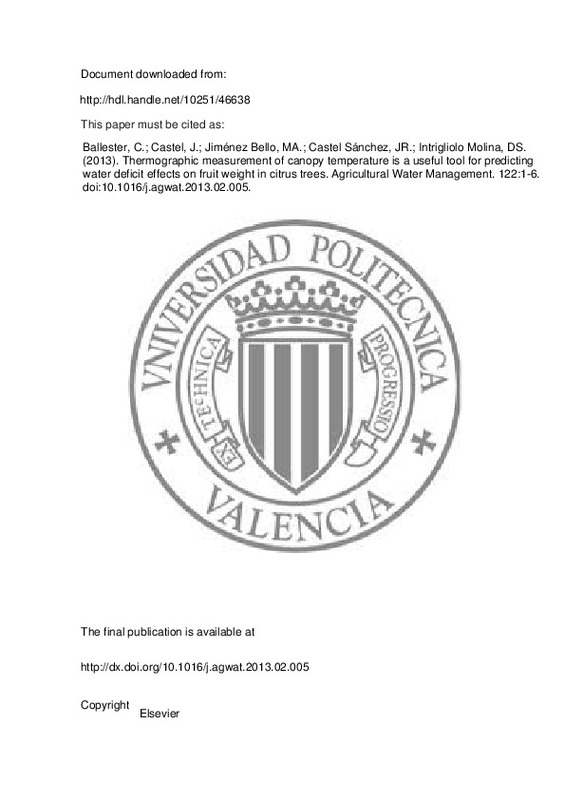JavaScript is disabled for your browser. Some features of this site may not work without it.
Buscar en RiuNet
Listar
Mi cuenta
Estadísticas
Ayuda RiuNet
Admin. UPV
Thermographic measurement of canopy temperature is a useful tool for predicting water deficit effects on fruit weight in citrus trees
Mostrar el registro completo del ítem
Ballester, C.; Castel, J.; Jiménez Bello, MÁ.; Castel Sánchez, JR.; Intrigliolo Molina, DS. (2013). Thermographic measurement of canopy temperature is a useful tool for predicting water deficit effects on fruit weight in citrus trees. Agricultural Water Management. 122:1-6. https://doi.org/10.1016/j.agwat.2013.02.005
Por favor, use este identificador para citar o enlazar este ítem: http://hdl.handle.net/10251/46638
Ficheros en el ítem
Metadatos del ítem
| Título: | Thermographic measurement of canopy temperature is a useful tool for predicting water deficit effects on fruit weight in citrus trees | |
| Autor: | Ballester, Carlos Castel, J. Castel Sánchez, Juan Ramón INTRIGLIOLO MOLINA, DIEGO SEBASTIANO | |
| Entidad UPV: |
|
|
| Fecha difusión: |
|
|
| Resumen: |
[EN] Alternative and more practical methods for plant water stress detection than stem water potential (ψs) and stomatal conductance (gs) are needed when regulated deficit irrigation (RDI) strategies are applied. The aim ...[+]
|
|
| Palabras clave: |
|
|
| Derechos de uso: | Reserva de todos los derechos | |
| Fuente: |
|
|
| DOI: |
|
|
| Editorial: |
|
|
| Versión del editor: | http://dx.doi.org/10.1016/j.agwat.2013.02.005 | |
| Código del Proyecto: |
|
|
| Agradecimientos: |
The authors thank H. Hernandez and T. Yeves for their help with the field work. This experiment has been funded by the RIDECO-CONSOLIDER CSD2006-00067 and Telerieg Interreg IV Sudoe projects. C. Ballester was holder of a ...[+]
|
|
| Tipo: |
|







![[Cerrado]](/themes/UPV/images/candado.png)


